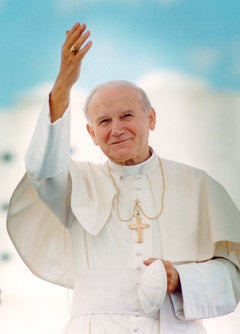 The longest reigning pope in modern history, John Paul II, took his message on the road, visiting 129 countries --several repeatedly -- on 104 trips and logging more than 700,000 miles in a
papacy that lasted more than 27 years. Blessed John Paul died at the age of 84 at the
Vatican April 2, 2005, the vigil of Divine Mercy Sunday.
The longest reigning pope in modern history, John Paul II, took his message on the road, visiting 129 countries --several repeatedly -- on 104 trips and logging more than 700,000 miles in a
papacy that lasted more than 27 years. Blessed John Paul died at the age of 84 at the
Vatican April 2, 2005, the vigil of Divine Mercy Sunday.
Pope John Paul also instituted the annual February 2 World Day of Consecrated Life, the February 11 World Day of the Sick and a World Meeting of Families every three years. But welcoming hundreds of thousands of young people to the Vatican for a special Palm Sunday celebration in 1984, Pope John Paul launched what has become the biggest international gathering on the church's calendar: World Youth Day.
In his later years, the pope moved with difficulty, tired easily and was less expressive, all symptoms of the nervous system disorder of Parkinson's disease. Yet he pushed himself to the limits of his physical capabilities, convinced that such suffering was itself a form of spiritual leadership.
Here are some important dates in the life of Blessed John Paul II:1920: Karol Wojtyla is born May 18, baptized June 20 in Wadowice, Poland.
1929: His mother dies; he receives first Communion.
1938: Moves to Krakow with father; enters Jagellonian University, joins experimental theater group.
1940: University studies interrupted; he works as manual laborer during World War II.
1941: His father dies.
1942: Enters secret seminary in Krakow.
1944: Is hit by a car, hospitalized; is hidden in archbishop's home to avoid arrest by Nazis.
1945: World War II ends; he resumes studies at Jagellonian University.
1946: Nov. 1, is ordained priest; goes to Rome for graduate studies.
1949: Named assistant pastor in Krakow parish.
1954: Begins teaching philosophy at Catholic University of Lublin; earns doctorate in philosophy.
1958: Sept. 28, ordained auxiliary bishop of Krakow.
1962: Goes to Rome for first session of Second Vatican Council.
1963: Attends Vatican II second session, is named archbishop of Krakow Dec. 30.
1964: Is installed as archbishop of Krakow; attends council's third session.
1965: Makes three trips to Rome to help redraft Vatican II document on church in modern world; attends final council session.
1967: June 28, is made cardinal; named to first world Synod of Bishops but stays home to protest government's denial of a passport to Poland's primate, Cardinal Stefan Wyszynski.
1971: Attends first of several bishops' synods in Rome; is elected to its permanent council.
1978: Oct. 16, is elected 264th pope and bishop of Rome; visit to Assisi is first of 146 trips within Italy; visit to a Rome parish marks start of visits to 317 of Rome's 333 parishes.
1979: Visits Dominican Republic and Mexico, his first of 104 trips abroad as pope; also visits Poland, Ireland, United States and Turkey; publishes first encyclical, apostolic exhortation; convenes first plenary meeting of College of Cardinals in more than 400 years; approves Vatican declaration that Swiss-born Father Hans Kung can no longer teach as Catholic theologian.
1980: Convenes special Dutch synod to straighten out problems in Dutch church; becomes first modern pope to hear confessions in St. Peter's Basilica.
1981: May 13, is shot, severely wounded; names Cardinal Joseph Ratzinger head of Vatican doctrinal congregation.
1982: Marks anniversary of attempt on his life with trip to Fatima, Portugal; meets with Palestinian leader Yasser Arafat; makes Opus Dei the church's first personal prelature.
1983: Promulgates new Code of Canon Law; opens Holy Year of Redemption; visits would-be assassin, Mehmet Ali Agca, in prison.
1984: Establishes diplomatic relations with United States.
1985: Warns that abortion in Europe is "demographic suicide"; convenes special bishops' synod to review 20 years since Vatican II.
1986: Makes historic visit to Rome's synagogue; calls world religious leaders to Assisi to pray for peace.
1987: Opens Marian year and writes encyclical on Mary; attends first international World Youth Day in Argentina.
1988: Approves issuance of Holy See's first public financial report; issues encyclical, "On Social Concerns"; issues letter defending women's equality but saying they cannot be ordained priests; sets up Vatican commission to try reconciling followers of schismatic Archbishop Marcel Lefebvre.
1989: Is widely seen as key figure in collapse of communism in Eastern Europe.
1990: Issues first uniform law code for Eastern Catholic churches; issues global norms for Catholic higher education; approves Vatican instruction on theologians; establishes diplomatic relations with Soviet Union.
1991: Issues encyclical marking 100 years of Catholic social teaching; convenes special European synod to deal with rapid changes in wake of communism's collapse.
1992: Has benign tumor on colon removed; issues official "Catechism of the Catholic Church."
1993: Writes first papal encyclical on nature of moral theology.
1994: Declares teaching that women cannot be priests must be held definitively; establishes diplomatic relations with Israel; publishes book, "Crossing the Threshold of Hope"; named Time magazine's "Man of the Year."
1997: Names St. Therese of Lisieux a doctor of the church; presides at synod for America, one of a series of regional synods.
1998: Historic Cuba visit is 81st trip abroad; starts first permanent Catholic-Muslim dialogue.
1999: Unseals Holy Door in St. Peter's to start jubilee year 2000.
2000: Presides at numerous jubilee year events in Rome; makes historic visit to Holy Land.
2003: Marks 25th anniversary as pope; beatifies Mother Teresa of Kolkata, one of record number of beatifications and canonizations under his pontificate.
2004: Opens Year of the Eucharist.
2005: Publishes new book, "Memory and Identity: Conversations Between Millenniums"; hospitalized, undergoes tracheotomy. Dies April 2.
2011: May 1, beatified by Pope Benedict XVI.
